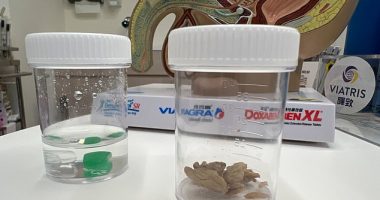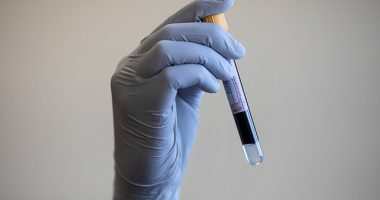Venomous bites and stings from spiders, scorpions, snakes, lizards and jellyfish — even caterpillars, snails and octopuses — hurt millions every year and kill many thousands globally.
But these animals’ poisons are poised to help provide a new wave of medicines to treat everything from cancer to heart disease — even to slow down ageing.
This isn’t just some distant hope. Already a lethal animal venom is the secret behind the blockbuster weight-loss drug semaglutide, better known as Wegovy and Ozempic.
What’s more, viper venom underlies drugs called ACE inhibitors, which are taken by thousands of people in the UK for high blood pressure.
Ozempic and Wegovy earned their maker a startling £15billion last year, with a swarm of celebrity endorsements from TV personality Sharon Osbourne and former pop star Boy George to billionaire investor Elon Musk.


The secret of Ozempic’s success lies in the Gila monster, which grows up to 2ft long and is the only venomous lizard native to the US


Ozempic and Wegovy earned their maker a startling £15billion last year, with a swarm of celebrity endorsements from stars including Sharon Osbourne and Elon Musk
But the secret of these weight-shrinking drugs’ success lies in a mean-looking reptile, the Gila monster, which grows up to 2ft long and is the only venomous lizard native to the US.
Human fatalities from its bite are rare, though earlier this year coroners in Colorado reported that a local man, Christopher Ward, 34, died ‘due to complications of Gila monster envenomisation’ after being bitten on the hand by one which he had been keeping illegally as a pet.
A bite from the venomous jaws can cause swelling, intense burning pain, vomiting, dizziness, a rapid heart rate and plummeting blood pressure. But Gila venom also enlarges and over-stimulates the pancreas — the organ that makes the hormone insulin which helps regulate hunger and blood sugar levels.
Nearly 35 years ago, Dr John Eng, an endocrinologist at the Veterans Affairs Medical Center in New York, realised this meant that a chemical in the venom might have dual use — the lizard uses it not only as a poison, but also as a hormone to control its production of insulin very tightly.
Gila monsters, in their desert habitat, catch prey infrequently. But during long periods of starvation they are able to slow down their metabolism and maintain constant blood sugar levels. Dr Eng wondered if that close control of insulin could help humans with type 2 diabetes, where their blood sugar levels have gone out of control.
He trawled through the hundreds of chemical components in Gila venom until he identified a small protein that he called exendin-4.
This looked similar to glucagon-like peptide-1 (GLP-1), a hormone found in the human pancreas that regulates insulin and appetite when our blood sugar levels are high, such as immediately after a meal. But while GLP-1 remains active in the human body for about two minutes, exendin-4 remains active for hours, suggesting it could have a long-acting effect on regulating blood sugar and appetite so that people feel satiated despite eating less.
In 2005, Dr Eng’s work culminated in a drug synthesised from exendin-4 to treat type 2 diabetes. It was launched as the world’s first GLP-1 mimicking drug, exenatide (also known by the brand name Byetta).
Rival drug companies vied to make their own exenatide-type drugs with greater effectiveness. The first clear winner to emerge was semaglutide, made by the Danish pharmaceutical company Novo Nordisk and marketed under the brand name Ozempic.


A bite from the venomous jaws of a Gila monster can cause swelling, intense burning pain, vomiting, dizziness, a quickening heart rate and plummeting blood pressure


Scientists are mining venoms for new therapies for numerous diseases in a scientific field known as ‘venomics’
This proved highly effective both against type 2 diabetes and appetite — and later a different dose, marketed as Wegovy, proved effective as a weight-loss drug.
Such success has bolstered the efforts of scientists who are mining venoms for new therapies for numerous ills. This field even has its own name — venomics.
More than 220,000 species, or approximately one sixth of all animal species on earth, are venomous, and each creature’s venom is unique.
For example, while a spider’s may contain thousands of active chemicals, a scorpion’s might have only several hundred.
These venoms are the result of millennia of competition between predator and prey, where each time one evolves a new immune defence the other develops a new method of poisoning.
Dr John Finger, a biologist at Auburn University in Alabama, made an astonishing discovery in 2020 when he reported how alligators have evolved chemicals in their blood that actually block deadly snake venom.
‘This allows alligators to eat venomous pit vipers and they may not succumb to getting bitten by them,’ Dr Finger wrote in the Journal of Herpetology.
Snake venom may hold enormous potential for new drugs.
In 1981, captopril was launched as the first drug developed from animal venom — in this case the jararaca snake, a species of South American pit viper. Scientists had noticed that its bite made its victims’ blood pressure plummet, and researchers discovered the venom contained chemicals that prevent our bodies from making a hormone called angiotensin 2.
This substance narrows the blood vessels, and blocking it causes them to relax, which lowers blood pressure as the vessels dilate more easily.
The drug synthesised from the viper venom became the first of a new class of oral medicine called angiotensin-converting enzyme (ACE) inhibitors. GPs in the UK now issue about 65million prescriptions for them each year.
Meanwhile, other venoms have provided similarly revolutionary drug treatments, with many more showing great promise for the future. Here are some of the most significant breakthroughs…
Octopus
The venom of an Australian octopus could help tackle lethal melanoma skin cancers.
Dr Maria Ikonomopoulou, head of the Translational Venomics Group at the IMDEA Food Institute in Madrid, is currently developing a drug from venom used by the southern sand octopus to defend itself from sea anemones.


The southern sand octopus’s venom is used to defend itself from sea anemones – but may also be able to stop melanoma tumours growing
Called Octpep-1, it has been shown in laboratory experiments to be able to stop melanoma tumours growing.
A report in the British Journal of Pharmacology said it appeared to work against melanomas driven by a mutation in a gene called BRAF V600E, which is involved in about half of cases of melanoma.
‘It’s particularly exciting because Octpep-1 specifically targets cancer cells and only minimally effects healthy cells,’ Dr Ikonomopoulou told Good Health.
‘This is very valuable, because existing drugs for this type of cancer can be significantly toxic, which limits the amounts patients can receive.’
Dr Ikonomopoulou is also exploring how venoms from marine animals could be used to create anti-ageing drugs by targeting so-called zombie cells in the body which are alive but do not function as they should.
‘There is huge interest in this field of science,’ she adds.
Spiders
An Australian spider which produces venom that is among the world’s most lethal also has major potential as a treatment for heart attack and stroke.


The funnel web spider’s venom contains 3,000 active chemicals – making it one of the most complex in the world
The K’gari funnel web spider was only discovered in 1995, when someone was bitten by one. Scientists then found that its venom contains about 3,000 active chemicals, making it one of the most complex in the world.
In January, researchers at Queensland University published a study in the European Heart Journal which showed that a substance extracted from the venom, called Hi1a, protects cells in parts of the heart that are damaged by heart attack.
The theory is that this could be injected into tissue immediately after a heart attack, or also to protect the brain after a stroke.
‘Hi1a could reduce damage to the heart and brain during heart attacks and strokes by preventing cell death caused by a lack of oxygen,’ says Glenn King, a professor of molecular bioscience and one of the investigators.
Snakes
Snakes are popular with researchers because of the large amount of venom they produce compared with smaller animals.


Tirofiban is derived from the venom of a saw-scaled viper, and can stop harmful clots forming in the arteries after a heart attack
Tirofiban, a widely used drug derived from the venom of the saw-scaled viper, was first approved in Europe and the UK 25 years ago.
This notorious viper is to blame for the most snakebite deaths in the world, as its venom causes catastrophic internal haemorrhaging so victims can swiftly bleed to death.
In 1987, scientists at Temple University School of Medicine, in Philadelphia, reported how a chemical in the venom, called echistatin, can prevent human blood platelets sticking together and clotting.
This led to the development of tirofiban, which prevents harmful clots forming in the arteries in the wake of heart attacks, or while patients are undergoing surgery to treat a blocked coronary artery.
In February, at the International Stroke Conference in Arizona, researchers from China reported that giving patients tirofiban promptly after strokes can protect their brains from further damage better than the current treatment, aspirin.
Snails
Until ziconotide, a powerful painkiller derived from sea snail venom, was approved for human use in Europe in 2006, no new drugs for chronic pain had been introduced for more than four decades.


Cone snails have one of the deadliest stings on earth, which can paralyse fish before the snail eats it whole
Ziconotide is based on chemicals in a toxin produced by the cone snail, which has one of the deadliest stings of any creature on Earth. The snail uses its venom to paralyse fish before swallowing them whole.
In humans, the sting can cause potentially fatal paralysis of the lungs.
Scientists at the University of Utah, who analysed it in the late 1990s, found that certain chemicals in the poison can also block pain by preventing nerve cells from sending pain signals to the brain.
The drug can, however, only be injected directly into the fluid surrounding the spinal cord, through a small pump worn by the patient, which is both painful and invasive. It’s therefore reserved for those suffering extreme pain, such as cancer patients.
Caterpillars


The ASP caterpillar is covered in hairs known as its ‘toxic toupee’
ASP caterpillars, which live on oak and elm trees in North America, have long hairs that locals call ‘toxic toupees’.
These hairy creatures use these prickly spines to inject strong venom into their victims. Patients liken its effect to touching burning coals or being hit with a baseball bat, and it can lead to hospitalisation.
But now the caterpillar venom may also provide a vital new way to get life-saving medicines inside human cells.
Last year it was reported, in the journal Proceedings of the National Academy of Sciences, that the venom of asp caterpillars contains a protein that can poke holes in cells. The caterpillars, which grow into flannel moths, use this mechanism to make their victims’ cells send debilitating pain signals to their brains.
Dr Andrew Walker, a molecular bioscientist at Queensland University, says that this novel mechanism may ‘get drugs inside cells where they need to work’.
This might, for example, enable powerfully toxic cancer drugs to be targeted precisely at tumour cells without harming surrounding healthy cells.
Source: Mail Online







